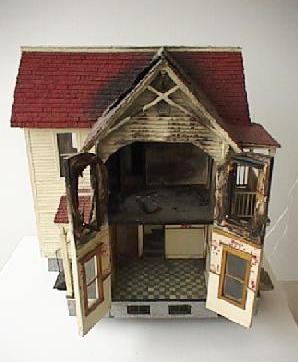Broken Home
Curated by Meg O'Rourke and Caroline Schneider
Greene Naftali Gallery, NYC
May 3 - June 7, 1997
526 West 26th Street
a review by
Peter Fend

Rober Gober.
"Burnt House", 1987.
In the English language, "broken home" refers to the family. The bonds between mother, father and children have turned sour or ruptured; individuals are weakened or uprooted as a result. This exhibition visibly has nothing to do with the term; in many cases, it presents the complete opposite.
"Broken Home" is a joke. Nothing in it has to do with "broken homes", so even the title is, I guess, a sort of joke. The curators have some riddles to dangle before us, and we have to catch on to... the joke. Even if I get past the conundrum and say, okay, it's really just about some aspects of architecture and not about any broken homes, so the title was just a teaser, I still ask, What am I learning about architecture--or about "house", or "home", to use O'Rourke's phrase?
When you enter, you see, on the floor, a 1:25 (or so) model of a surrealist fantasy suburban tract. It's by Vito Acconci, so it takes some ideal to absurd lengths; in this case, the ever- coveted "swimming pool" becomes a giant serpentine pit surrounding and connecting all the houses. Not likely, not buildable, not legally feasible, essentially a joke. Maybe an important joke. But certainly not a joke about "broken home." More likely a joke about American consumerism.

Vito Acconci.
"Proposal for a Courtyard in a Housing Complex,
Regensburg, 1988."The Absalon space capsule appears, particularly on the performance videotape, like some afterlife chamber for some Pharoah deep in his (high-tech) pyramid. A man in his body-encasing bed awakens, comes to life, takes a leak (joke), wanders around with nothing to do (is this heaven; joke), and is left with little choice--given no windows, no outdoors, no living world at all--but to return to his body-encasing coffin-bed. The first sensoria affected are my nostrils; I instantly imagine that after several days, even several hours, the place must unbearably stink. No wonder the guy died so young. At least when the models were life-size, and when there was no video performance, one could play with his smooth-coated spaces without fear of rotting inside.
The closest to a "broken home" piece is the Gober. There'a toy house which has been partly burned down. Well, the children had a Charles Addamms sense of humor, and any parent would be worried if this what they did to the toy home for which they paid so much. What about the real home? But hardly anyone lives in such houses, hardly ever would any child behave thus, so the net sense of the Robert Gober is... Charles Addamms cartoon. I'm laughing, but not worried.
There's "made for TV." The video projection by Jane and Louise Wilson is a tour-de-force performance in an empty industrial building by two sisters, so closely bonded and so compatible in their artistic and social lives (meet them, and you face two personalities intertwined into one force) that they manifest the exact opposite of a "broken home." They're acting out their youth, they're doing what you in your individuality could never do, and you're watching.
The Isa Genzken doesn't have to do with house or home. The Franz West has to do with sloppiness. The Gonzalez-Torres is just a jigsaw puzzle of a house, with possibly some implications--if you like--of what it all could "mean." The Brobdingnagian doorhandle by Artschwager is a fixture for King Kong, an architectural-hardware version of Oldenburg, but it has nothing to do with either house or home. The Glen Seator was about house-cleaning; something noxious you have to do in a space. The wall photographs of corners were... photographs. The Peter Land video was... Peter Land. The Vito Acconci ladder/lawn chair was.. a ladder/lawn chair.
One piece stood out on the question of home: the rug with stuffed animals in consult sitting around it. This was a true home. This was a model home. This was even an ideal home, if you accept the stuffed-animal parable. But it was no broken home. Nice piece, by Mike Kelly, all made with objets trouves in a pleasant theatrical grouping, but wrong for the show as titled.

Mike Kelly.
"Arena #7, (Bears)," 1990.If Architecture is the domain of this show, then three works deserved attention. None else. All the other works were not really about architecture, as a building practice with consequences. These were the Dan Graham, the Gordon Matta-Clark and the Nils Norman. All the works were interesting and have art-historical importance. None have anything to do with "broken home," or even with "home" or "house" at all. The Dan Graham is another of his precisely crafted models of a mirror, scrim, angled wall piece, all with the minimal aesthetic of Michael Asher and Robert Irwin, or possibly early mirror pieces by Robert Smithson. But while an architect might find a way to "learn" from this work, and might find a way to build an inhabited structure or even garden with this work, or even while the artist might possibly graduate into building inhabited spaces and gardens with this work, it has nothing now to do with what we live in.
Only one piece had architectural significance. It had implications. This was the now-famous sliver-lot or spare-corner purchase piece by Gordon Matta-Clark. IF an architect were to do what Matta-Clark did, and IF that architect were to also secure air-rights over any property between the leftover small plots, the architect could build giant straddling or hovering or tensile structures up over the normal city fabric, effecting megastructural fantasies unachieved since they were first conceived, in the beginning of the century. One can responsibly encourage more real-world practices following upon Matta-Clark, and even--if only for certain aesthetic effects--upon Nils Norman and Dan Graham.
This show was not architectural. It was not physical. It was not generated from kinesthetic and spatial experience. It was written. It was literary. It was generated from texts. It was a scholarly exercise, with lots of lofty phrasings but not even a rudimentary attention to definitions. As an attempt to move from art into architecture, it fails.
Peter Fend
Email: ThingReviews
To post a response fill out the following form and click the "Submit" button. Or go back...
Scroll down to read messages.
--
Responds:
Bill Previdi -- PowerrBill@aol.com
Responds:
While I do think you're taking the title of the show a little too literally, I agree that the inclusion of some of the works in the show was a little contrived. The Artschwager could easily have been replaced by any number of Jeff Burton's photographs of home interiors rented out to porn filmakers. And the Julie Becker's should have been left out in favor of Tim Heins' paintings of houses in which the inhabitants act out tabloid-style suburban mini-dramas. The inclusion of the Seator piece made little sense to me. Who uses a pushbroom to clean up a broken home?
